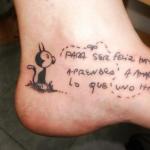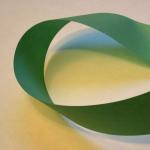A paper panel is an unexpected grace (56 photos). Paper panel - unexpected grace (56 photos) Beautiful paper panel
Any wall decoration after renovation gets boring, you want to change something and find a way to show your imagination, talent and creative skills.
A three-dimensional panel made from scrap materials is one of fashion trends in design 2017.

Looking through spectacular illustration work can seem overwhelming. But if in school labor lessons you got excellent results from plasticine and salt dough figures, and you have experience working with beads or natural materials, everything will work out.

What material to choose for wall decoration
Panel on the wall self made- special decor that can enliven the most ordinary surroundings, introduce a new design concept and enliven the atmosphere.

The choice of material and technique to implement an idea depends on many factors:
- Functionality of the premises;
- Wall decoration;
- Creative inclinations;
- Tastes and preferences;
- Availability of materials and tools;
- Skills in working with materials (sewing, knitting, modeling, weaving, drawing).
It is better to place a large panel on the entire wall in a large room where there is a lot of empty space. The easiest way is to buy a painting or put up photo wallpaper. But there is nothing original in this, plus high costs, and new object I'll get bored soon.

Another thing is your own “masterpiece”, which you can proudly display to all visitors to your home.

Looking at the unique work, friends and relatives will be interested in how to make such a panel with their own hands?

First, it is better to choose a free wall, and then decide what it will be - a collage of photos, a drawing, modeling or a mosaic of broken tiles. The general design and plot of the image must correspond to the functionality of the room and practicality in care.

For example, it’s easy to paint aquarium fish on a smoothly painted wall on the wall of a bathroom, but the paint must be durable and indelible.

If the material is susceptible to destruction or dust accumulation, it is better to coat the finished product with a colorless varnish, like a photo panel made of salt dough.
The paint base for the panels must match the wall cladding material. For example, if it is acrylic enamel, then acrylic paints are also suitable for painting walls.

The walls in the nursery can be decorated with wallpaper panels, which can be easily built together with the child from the remnants of rolled materials left over after renovation.

Tip: Give the kids some of the exciting process creating homemade decor. They will willingly join in creative process. This will help development fine motor skills fingers and spatial thinking.

Children can collect natural materials– beautiful twigs, leaves and cones for panels. If you don’t know how to draw, have your child spray paint from a can onto a stencil.

They will enthusiastically circle large Maple leaves on cardboard, cut out their outlines in order to spray a contour pattern with gold and silver paint on the walls in the hallway. Aerosol paints and stencils in the decor of any room - The best decision for those who can't draw.
Panels of edible products for the kitchen
The kitchen is the domain of products, where many bulk materials are suitable for decoration. Before you make a panel with your own hands, make an inspection of your cabinets.
Note!


Beginning decorators have a whole natural palette at their disposal, which will preserve it for years. natural color. A panel of coffee, cereals and spices will decorate a free part of the wall in the dining area.

The work is carried out in several stages:
- Choose the sample you like.
- Make a sketch with your adjustments and mark it with squares to enlarge the drawing on the wall when enlarged.
- Apply markings and outlines of the panel with a simple pencil.
- Apply glue to decorative fragments for a specific product.
- Finished areas must dry naturally, after which you can move on to neighboring elements until the entire picture is completed.

Advice: To avoid disagreements, it is recommended to agree on the plot of the panel with all family members.

Any “appetizing” materials are suitable for the kitchen:
- dried, worn-out tea leaves are the black and brown contours of any design or soil in a painting;
- semolina is an excellent light base that can be additionally painted; it can also be used to fill empty areas;
- coffee beans (green and roasted) are an excellent material in brown and green tones;
- white and colored rice - variety of sizes and shades;
- peas, beans, lentils and beans - white, yellow, orange, reddish and green fruits different shapes, applied to the glue in halves;

- poppy – black base of the design;
- instant coffee and chicory, cocoa powder and ground cinnamon - a loose base of brown shades;
- pumpkin, watermelon and cucumber seeds are excellent material for DIY panels; they are also glued in halves;
- chaff or grains of millet, corn and wheat, cereals and pearl barley - an inexpensive base of different colors and textures.
It is advisable to carefully open the finished panel with colorless varnish in 2-3 layers, so that over time it can be easily cleaned from dust.
Note!


The image can be left as if unfinished or limited by a side (frame). Decorating a kitchen together is a fun activity that can easily involve three generations of family members.

Interesting ideas will be suggested by experts who recorded a master class on making panels with their own hands:

Those who are good at sculpting figures, small sculptures or making dolls from any material should master the technique of working with salt dough.

For a relief panel, mix fine salt with flour 2:1, adding a little vegetable oil, water and dry wallpaper glue, kneading like regular dough. It should be plastic, but quite hard.

The finished mass should not stick to your hands. Small pieces or balls are separated from it, from which the faces of the characters, fruits, leaves and other elements of the panel are made. It will hold up better if mounted to a frame as a portable decoration or attached directly to the kitchen wall.
Note!


You can add any other material to complete the story, such as embroidered fabric, beads or yarn.

The relief painting dries for about a week, but then it turns out to be a hard, durable material. The finished creation can be decorated and varnished, like the photo of the presented panel.

Advice from experts on making panels from various materials
Making your own decor is a fascinating creative process. Usually, after mastering one of the techniques using the example of decorating from dough or cereals for the kitchen, you want to move on to decorating other rooms.

In a children's room it would be appropriate to decorate with autumn leaves or colored paper panels made of fabric using the patchwork technique.
The needlewoman’s bedroom will be decorated with a panel of flowers, leather, fabric or buttons. A popular theme is a money tree, where you can add coins or green coffee to the buttons.

For a bathroom or bathroom, an excellent decoration would be “sea” material – smooth colored pebbles, shells and coral branches.

The living room will be decorated with cork, bamboo, ornamental stone. In skillful hands, any material will become the basis for a homemade masterpiece.

DIY photo panel



I bring to your attention 8 options for wall panels made of paper or cardboard. So in a simple way You can use waste paper waste to beautifully decorate and decorate the walls of your own home.
Eight DIY wall panels made of paper and cardboard:
1. Incredibly beautiful panels can be made from leftover paper. We will need paper and glue. You can use any paper of any color, density and quality.




We simply roll up paper rolls and glue them onto the base. The base can be a sheet of cardboard, plywood, board or just a wall. You can lay out the rolls randomly, or you can apply a pattern to the base in advance and lay them out in accordance with the intended pattern.




2. Simply amazingly beautiful panels made from paper bags.
Every person who passionately loves seeds probably knows how to roll a paper bag. But not everyone has heard about what can be made from such bags, other than pouring seeds into them.



Using multi-colored notes for writing, you can create a real miracle. Just roll the paper into little balls and place them in a fan shape on a frame base or thick cardboard. You can attach such bags using regular glue: stationery or PVA. You can also frame the finished painting in a frame with glass, but in this case you will have to spend money and purchase a deep custom-made frame.
3. Such frames remind me of forged Mexican panels with curlicues. I'll tell you, it's not a cheap pleasure if you order it. But making it out of paper is a completely different matter.

You will need thick black paint - at least acrylic or gouache. And scissors. Cut cardboard strips from rolls toilet paper and make curls using scissors. Make an openwork composition using glue; it is more convenient to use a glue gun.
5. And now several options for how to easily make designer panels on the wall. To do this, you only need a base - plywood, a chipboard, on which cut circles from toilet paper rolls will be attached.






Here your imagination will help you create a lot of interesting plots. The number of blanks that you need to collect depends on how large a tree you want to “grow” on your wall. The cylinder tubes need to be painted with gouache or tempera (preferably, it is more durable and does not wear off after complete drying), it is better to use several shades of green and brown, so the texture of the panel will look more interesting and richer.



After the paint has dried, we press the tubes with our hands and make them flat, and then cut them with sharp scissors 2 cm wide, then straighten them a little to make “leaves” in cross-section. On a large sheet of paper we draw a tree (you can take a sheet of paper drawn into squares if you want to copy the outline of the tree from somewhere, cell by cell), schematically delimiting the “crown” of the tree and its “trunk”.
6. Bright wall panel made of stickers. So simple and so original! Absolute freedom for fantasy. You can choose the shape, colors, you can easily change both.

You can call this original panel of colored paper squares a wall patchwork.
7. Panel made of colored paper. Once you have decided which colors will be present in your panel, you need to purchase the corresponding colored paper. As an example, we will use rounded elements in four colors. So, we need 40 elements (20 cm in diameter), therefore 10 of each color.



Colored paper is available in various formats and weights. Even the thinnest A4 format will suit us. This can be regular colored xerox paper. The A4 format has a size of 21x29 cm, that is, it is quite suitable for us in order to cut out circles from it with the diameter that we require. Next, you need to laminate all 40 sheets of paper. Lamination will give the panel elements gloss and elegance, and will also provide it with enough long term storage
8. Panel made from twisted strands of paper. The paper is rolled into a tube, then these tubes are screwed along the axis onto the glue. The circles are connected to each other.

Home is the place where you want to feel as comfortable as possible. Eat various ways make it even more cozy. But it’s especially nice when the decorative elements are made by yourself. Decorative panels in the interior always attract admiring glances, and making them from scrap materials is not difficult if you follow the technology correctly and follow the instructions step by step.
What it is
The panel is a decorative element and its purpose is to decorate the interior and fill empty space on the walls or ceiling. Sounds a lot like the description of a painting, doesn't it? How does it differ from a painting, if both decorative options are designed to decorate the room? The answer is simple: a painting is a subject of painting art, and a panel can consist of anything. Dough, plastic, plaster, beads, fabric, wood - there is no limit to imagination when it comes to making panels and the material for decoration can be anything. If you want to make your interior unique, then the panel will do it perfectly!
Determining the scope of work
The first stage in creating a wall panel is to decide on the design of the future product. If you already know where it will be located, then this complicates the task. Need to weigh color scheme, dimensions, what it will have, whether the material from which it is planned to be made fits into the overall picture of the interior.
So, we decide: size, color scheme and what materials will be used. This is the first step. If this is possible, then it is worth drawing a sketch of the planned product. This will help take into account all the nuances in completing the task.
If a piece of cardboard, canvas or any other hard surface is taken as a basis, then markings are made on it: where and how the decorative elements will be located. If the base is fabric, then it is stretched onto the base (for example, onto a piece of plywood, board or plastic), and the rest of the fabric is secured on the back side. After the craft is completed, it is placed in a frame and hung on the wall.
There is another option for making panels on a fabric basis. You will need to take a solid base, for example, a plasterboard sheet of the required size and glue foam rubber to it. The fabric is stretched onto the resulting soft base. In this case, you can do without a frame.
After all the preparations, you can begin the main part of production: decorating.
Types of panels with your own hands
Let's look at the main types used in decoration:
| Fabric | These are all variants of embroidery, applique and tapestry techniques that are made on fabric. The technique can be anything: from hand embroidery to machine embroidery, made in mass production. |
| Stone | Often made using mosaic technique. Are used natural stones which are considered noble: basalt, marble and others. Less often, such products also contain artificial stone. |
| Made of ceramics | They are made using ceramic tiles and are usually placed in the bathroom or kitchen. |
| Sculptural | A volumetric version of the product, which is made of special plaster, plaster or metal. |
| Graphic | Everything done with various types print. These can be reproductions of paintings, photo printing. |
| Other types | Here you can find handmade products made using any available materials. Salty dough, wood, dried flowers and plants, shells, clay, beads - there is no limit to your imagination for decoration. |
Here are examples of manufacturing different types of panels:
From prints of fruits and vegetables
A child can also participate in the creation of this panel, as it is very simple to make. The bright, colorful design of this creation is ideal for the kitchen.
For production you will need:
- Solid vegetables or fruits (this could be apples, any citrus fruits, pears, cabbage, etc.);
- Paint (gouache, oil, acrylic);
- The basis on which the decoration will be made. It can be cardboard, board, fabric stretched over a sheet of drywall.
The surface of the base is pre-degreased and painted in the desired shade. Cut fruits and vegetables into halves and dip them in paint. It is best to pour the dye thinly into a plate. We apply the cut side of the colored fruit to the base and get a stamp.
Stamps can be made anywhere on the base, but images that are positioned symmetrically look best.
From paper
There are many options for making paper creations. Let's look at the main ones:
Made from round paper designs
This product can be made with your own hands in an hour and is an excellent way to decorate the interior, as well as get a lot of positive emotions.
Let's prepare materials:
- Colored paper;
- Paper clips;
- Scotch;
- Pins;
- Stapler.
Procedure:
- A sheet of paper is folded like an accordion, like a fan.
- We bend the accordion in half.
- Using a stapler, we secure the edges at the fold so that the accordion does not fall apart and you get a small fan. We connect three such fans and get a circle.
- Accordions of different colors can be combined into one circle, then the panel will turn out even brighter.
- Connect many circles together, attaching them to the wall with safety pins. The size of the circles and the composition itself can be as large as you like and take any shape.
From photographs
Essentially, this is a collage of photographs or artistic pictures, which can either have a specific theme or be completely abstract. Photos are combined into one composition and mounted on a wall or other base. Design option: combine multiple images of sea and sky.
From colored paper
There are a lot of options for making crafts from colored paper. Today we offer the “Flowers from Hearts” option, which is suitable even for children's master class. It is very easy to make, is an excellent tool for developing a child’s fine motor skills, and looks amazing!
We will need:
- Office colored paper;
- Basis for panels;
- Pencil;
- Scissors;
- Cardboard;
- Paints;
- Tassels;
- Frame.
Let's get started:
- Cut out a heart-shaped template. To make one flower, we need eight such hearts. All hearts in a flower must be the same size.
- Fold the heart in half and get a petal.
- Glue a flower from these petals onto the base. This could be cardboard or a wall.
- To make flower leaves, you need smaller green hearts.
- We lay out the flowers in any order, depending on the overall shape of the desired panel. It can be a heart shape, or you can arrange flowers in the shape of a tree. Let's show your imagination and bring it to life!
From newspaper tubes
Newspapers can be great for making your own panels.
Necessary materials:
- Newspapers;
- Knitting needle;
- Glue;
- Wire;
- Brush;
- Knife;
- Acrylic paint.
Procedure:
- We cut the newspaper sheet into two parts with a knife.
- Apply a thin layer of glue to these parts.
- We wind sheets of newspapers diagonally onto a knitting needle. You should get thin tubes.
- Let's take it acrylic paint and paint the newspaper tubes in the desired color.
- We coat the resulting flagella with glue again and wrap the ends of each newspaper tube so that we get a spiral. Both ends need to be twisted in opposite directions if you want to get the shape of a seahorse. You can make a circle: to do this you just need to roll the entire tube in a spiral.
- We secure the spirals with rubber bands and leave them to dry for 24 hours.
- We remove the rubber bands and make up the desired pattern from the resulting elements. The elements can be immediately mounted on the wall, or a panel can be created on a pre-prepared base.
Circles from newspaper tubes can be painted in different colors, combining several shades in one circle. Circles with a gradient look interesting: a transition from one color to another.
From wallpaper
This interesting solution, which will enliven your interior and give it even more comfort.
There are several ways to make a wallpaper panel yourself:
- Shred technique
Cut out fragments from existing wallpaper. The pieces can be of any shape, but must fit together. Consider the general appearance of the entire future composition. For example, you can cut out squares with flowers from three different types wallpaper and combine them together in several rows in a certain sequence. In this case, paired elements do not have to be arranged symmetrically.
- Whole wallpaper technique
We take wallpaper with the desired image (for example, a sakura branch), carefully cut it out and insert it into a frame, or glue it to the wall and decorate it with moldings or panels.
- Combination of styles
Here the design is limited only by your imagination! Combine solid pieces of wallpaper with small cut out pieces. This is a modern and inexpensive way to decorate your home.
Important! If you can’t decide on the style of the future composition, then you should take a closer look at the images of flowers and plants in soft shades. It is always appropriate and looks beautiful.
From salt dough
This type of panel is one of the most budget-friendly, since its production requires a minimum of material and usually everything you need is always at home.
We offer a version of a molded panel where your child’s arms and legs will be imprinted. This creation will allow you to decorate your baby's bedroom in an original way and preserve the memory of his childhood for a long time.
We will need:
- Flour;
- Salt;
- Colored gouache (optional).
Procedure:
- We take flour and salt in proportions of two to one. Two glasses of flour are mixed with a glass of salt, then water is added. The approximate volume of water for this amount of flour and salt will be 125 ml.
- Knead the stiff dough. If it sticks to your hands, then add more flour. The dough should be elastic and not stick to your hands.
- If you want to make the panel colored, then it’s time to add gouache, decorating the dough with it.
- Roll out the dough. Its approximate thickness should be about 2 centimeters. The shape of a piece of dough can be any.
- We bring the dough to the baby and gently press his palm and foot into the mass. The pressure should be light, but sufficient to leave a mark.
- We make two through holes in the dough - this is for the future ribbon, on which the panel will then hang.
- Place everything on a baking sheet and cover with baking paper.
- Preheat the oven to 90 degrees and put the dough there to dry. This will take approximately two to two and a half hours. It is necessary to carefully turn the dough once, halfway through drying.
- We paint the resulting panel with colored or white gouache, thread the tape through the holes - voila! A very touching and cute decoration for your home is ready!
From fabric
Decorating panels with fabric came into fashion not so long ago: only in last years handmade lovers paid close attention to the fabric. This product is ideal for a Provence style interior. Let's look at the main types of fabric panels that you can make with your own hands:
Patchwork
Are used various techniques for making such panels, but they all have one thing in common: the use of scraps of fabric in the work. There are many patterns for such products on the Internet. Panels can be either on a fabric basis or on rigid structures. You will need any fabric for making: from pieces of tulle to scraps of old bed linen.
Felt for creativity
Felt panels are one of the most popular among needlewomen. All you need are pieces of felt of different colors, a pattern for future parts of the picture, thread and a needle or glue and a base on which you plan to attach all the details of the panel. Felt is a very beneficial material for creativity: it will help bring all your fantasies to life. A felt panel will be an excellent decoration for a living room or hallway.
Burlap looks like an extremely inconspicuous material, but it begins to play with completely different colors when craftswomen use it in their work. Burlap can be used to cover a frame for a panel; it can be used as a basis for other materials: beads, lace and others. This rough material perfectly emphasizes the delicacy and sophistication of other fabrics.
A panel made of wool is the most a simple product in technology wet felting. This is an interesting process in which wool is compacted in a specific way to create felt. The design on such a panel can be anything: it all depends on the skill of the needlewoman.
If you want to take a single-color piece of fabric and draw a certain picture on it, then keep in mind that this is not as simple as it seems. It’s worth practicing on a rough draft, and then moving on to the fabric that you plan to use on the panel.
From beads
In this version of the panel, all or part of its elements are made of beads. First, the elements themselves are made, and then they are fixed to the base and, if desired, framed.
From threads and nails
This is far from new, but very interesting way make a panel with your own hands! Minimalism reigns here in the choice of materials, but this does not make the panel bland and boring, but, on the contrary, attracts admiring glances.
The whole point is that cloves are hammered onto a solid base. This can be done chaotically, or it can be done according to a certain pattern, which can be successfully found on the Internet. Threads are stretched between the nails in several layers. Thanks to this, a certain pattern is created.
From buttons
Ideal for beginners! You can use buttons to decorate a panel made of fabric or paper, or you can create a product made entirely of buttons. For this you will need
- PVA glue;
- Buttons;
- The basis.
Execution order:
- Draw a sketch on the basis: where the buttons will be located and what pattern they should represent together.
- Glue the buttons to the base with PVA glue.
The design can be anything: inscriptions, abstraction, flora and fauna and others.
Mirror panel
A modern panel created from pieces of mirrors. Complex versions can only be made by specialists, while simple ones are very accessible for independent work. The mirror panel will become additional lighting in the room.
Necessary materials:
- Mirror tiles;
- Liquid Nails;
- A base with wooden planks, if you plan to stick the mirrors not directly on the wall.
The principle of operation is clear: we combine various mirror pieces and attach them in the required order to a wall or other base using liquid nails.
They are usually made in an abstract style from a variety of wood types. Wooden panels with inlaid semi-precious stones look very advantageous in a classic interior.
Dried flowers and leaves
Great for children's creativity. We decide on the plot of the future work, and then glue dried flowers and leaves (juniper branches, tree leaves - any flora will do) onto a solid base (cardboard, fiberboard) using glue. Grains, seeds and twigs would be an excellent addition.
Cereals and seeds
A sketch of the future painting is applied to a solid, already painted base. Then, cereals and seeds are attached to the base using PVA glue. Large grains need to be glued individually, and small grains, for example, rice, should be poured onto the glue already applied to the base.









